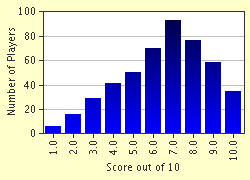Quiz Answer Key and Fun Facts
1. WG Grace was a powerful and popular English cricketer. His first class career spanned over 40 years from 1865 to 1908. His colourful cricket was not without controversy, and he would go to any lengths to win the game and promote himself. What underhanded and devious behaviour was he involved in?
2. It was 1932 and England captain Douglas Jardine was determined to contain the Australian legend Donald Bradman. He teamed with quick bowler Harold Larwood and developed the fast leg theory. Bowling fast-rising balls directly at the batsman was considered most unsportsmanlike. The Australian public were up in arms, as players were injured and even hospitalised. What was the name given to this unnerving method of bowling?
3. In 1947, Indian bowler Vinoo Mankad dismissed batsman Bill Brown in a manner that was considered to be "not cricket". What did he do that caused his name to be ignominiously enshrined in cricketing history?
4. In 1977, one of cricket's best kept secrets was revealed. 35 of the world's top players were signed up to play a series of matches involving Australia's best against the "Rest of the World". Battle lines were drawn as players either joined the well paid "rebels" or stayed with the establishment to play "real cricket". The age of television had come to cricket. Who masterminded this coup, changing the staid face of the game forever?
5. In February 1981, Australia were playing New Zealand in a One-day International game. New Zealand needed to score six from the final ball to tie the match. This was an unlikely event given that the delivery was to be bowled to New Zealand's number ten batsman. Australia's captain Greg Chappell ordered the bowler, who just happened to be his younger brother Trevor, to bowl the final delivery. He asked that it be underarm along the ground. This ensured that a six was not scored and the New Zealand batsmen walked off the field in disgust. Who was the batsman who faced the controversial delivery?
6. Australia's fast bowler Dennis Lillee was a ferocious competitor in a career that was certainly not without controversy. Opening the bowling for Australia with another quick, Jeff Thomson, the pair terrorised all comers. Which infamous incident involving Lillee made headlines around the cricketing world?
7. The match-fixing scandals which emerged in the final years of the 20th century, rocked the cricketing world and saw the demise of a number of top flight cricketing careers. Almost every cricketing country was involved. Hearings were held and judgements handed down. A number of the accusations came from an Indian bookmaker who leveled match-fixing allegations at many players. This bookmaker was Mukesh Gupta.
8. Much controversy has always surrounded the correct method of bowling. Laws relating to "chucking" rather than bowling are constantly under review. Modern technology has allowed close scrutiny and analysis of a bowler's action. While cricketers Brett Lee and Muttiah Muralitharan have had their bowling actions called into question, which Australian's career abruptly ended in 1963 when he was called for chucking?
9. Sledging or the exchange of disparaging remarks on the field has always been a colourful part of cricket. One of cricket's legendary batsmen was playing a county match in England and was on the receiving end of several unplayable bouncers. The bowler approached the batsman and commented "Mate if you can't spot the ball, I'll tell you what it's like. It is red, round and weighs five and a half ounces." Of course the batsman hit the next delivery right out of the park and into the river. He turned to the bowler and smiled, "Mate you know what the ball is like. Now go and find it." Who was this famous player?
10. Some cricketers have played outstanding cricket, and have demonstrated a true sense of fair play and sportsmanship at all times. In the early years of the 21st century, which Australian cricketer actually drew criticism from both players and commentators for "walking", after being given not out?
Source: Author
Nannanut
This quiz was reviewed by FunTrivia editor
Nightmare before going online.
Any errors found in FunTrivia content are routinely corrected through our feedback system.

